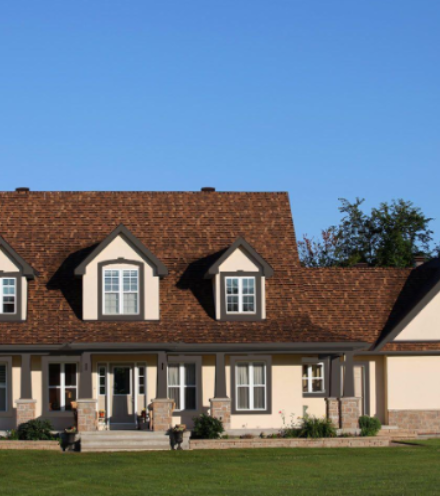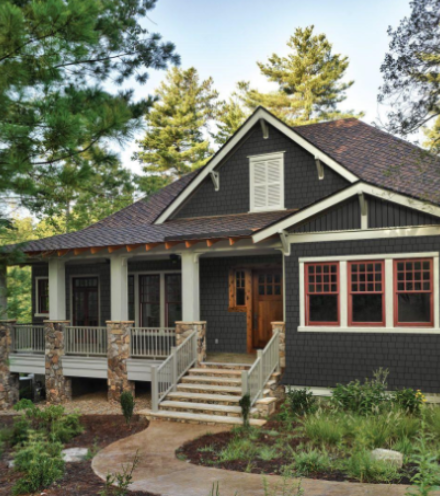With the increase in natural disasters, including hurricanes and other major storms, many homeowners and builders are turning toward weather-resistant building materials as they build or remodel.
Weather-resistant building materials handle things like hail, wind, rain, and snow without the same loss of integrity as building materials that have not been made to resist these elements.
There are many ways that you can help build a more weather-resistant home or building.
Weather-Resistant Building Materials for 2024
These weather-resistant building materials for 2024 are designed to help your exterior better withstand whatever Mother Nature brings.
1. Hail-Resistant Roofing
If you live in an area that sees frequent hail storms, such as Colorado, you understand the damage hail can do. Even small hailstones can cause major damage to your roof, either by bruising the mat of the shingle or by knocking the granules off, which exposes the mat beneath to the elements and hastens its deterioration.
Hail-resistant or impact-resistant roofing shingles are designed to handle the impact from hailstones as well as the type of high winds you’ll see in storms. A shingle that is called “impact-resistant” will have a Class 4 rating, which is the industry standard for a roofing material that can best withstand storm damage.
In some cases, you may also want to consider metal roofing, particularly metal tiles that have a stone coating. These types of roofing tiles are also impact-resistant as well as long-lasting. They can handle high winds, rain, and hail, so no matter what type of weather your area is subject to, hail-resistant and impact-resistant roofing, including metal roofing tiles, can make a big difference to how your home or building performs.
2. Moisture Resistant Insulation
Insulation is a standard among almost all homes. Without insulation, homeowners could expect cold winter nights and hot summer days. Not only does insulation keep unwanted temperatures out, but it also keeps air trapped inside the home. That being said, companies do make moisture-resistant insulation for areas with frequent storms and high humidity.
What you will most likely find in your home as insulation is fiberglass. Fiberglass insulation is commonly a pink or orange fluffy material, whereas moisture resistance insulation comes in foam-like boards.
There are different types of weather-resistant insulation. Specifically, there are two popular types; Expanded Polystyrene Insulation (EPS) and Extruded Polystyrene Insulation (XPS). When choosing between XPS vs EPS, it's important to understand the benefits of each and the differences. The difference between XPS and EPS insulation is in their manufacturing process. Both types of insulation use a polymer called polystyrene, but EPS uses steam and natural heat to shape this polymer, whereas XPS uses machinery.
Both EPS and XPS are a big upgrade from standard fiberglass insulation, and making the upgrade now could save you money in flooding and water damage in the future.
3. Impact-Resistant Windows
Glass windows and doors are frequently a source of concern during a major storm. Not only can they shatter, potentially causing injury, they also can potentially leave the property open to the elements, allowing rain or snow to enter, and vulnerable to intruders, who may see the opening as an invitation to enter.
Impact-resistant windows are designed with an inner layer that can help keep the window intact in the event of an impact. The glass itself may crack if the impact is hard enough, but it won’t shatter. This keeps the window safe; no worrying about winterizing windows or cracked and loose glass in or around your home or building. It also prevents the elements from entering and can help deter people who may try to take advantage of the storm’s aftermath.
Impact-resistant windows may still require replacement if the storm was bad enough to crack them, but they can help you avoid a lot more damage. While covering your windows is always the best choice, if you need to leave your home quickly and are unable to put plywood or hurricane shutters in place, having impact-resistant windows can help reduce the odds that you’ll come home to a bigger mess.
4. Fluid-Applied Flashing
Living in a high-density area for storms, you know that sealing your windows and other small home entry points can be vital to avoid flooding. However, you also most likely know that accidents and damage will occur no matter how much you try to avoid them. A solution to some of these accidents that may be happening is fluid-applied flashing.
Essentially, what fluid-applied Flashing does is tighten and improve your home’s envelope. Not only will this enhance the efficacy of your home and save you a couple of bucks going into the storm season, but it will also protect your home from possible damage that could occur because of small leaks.
Fluid-Applied Flashing is something to consider while living in an area known for storms and flooding. It would be smart to get this done right before the storm seasons to take care of any flash penetrations you might not have known about and seal your newly installed impact-resistant windows.
5. Concrete Framing
Many homes are stick-built, meaning that their frame is made of wood, regardless of what their outer covering is. Stick built and wood-framed homes are fine for ordinary weather and conditions, but if you live in an area that is subject to more extreme weather, it may not be enough.
Poured concrete and ICF construction are both becoming more popular as framing materials, because they’re stronger and can better withstand natural disasters. Both materials offer a lot more stability than wood, and are less affected by things like moisture. They also hold up better to high wind speeds and impact. They can be clad in many other materials, so you can still get the look and style you want for your home, with an increased resistance to the elements.
Some types of reinforced concrete frames and ICF blocks also help create homes that are resistant to earthquakes as well. These types of frames are much more stable than wood and resist bowing, cracking, or splitting with impact or ground movement, so your home or building is more likely to survive no matter what the conditions.
6. Fiber Cement Siding
Regardless of what the frame of the home or building is constructed from, the siding or cladding is its first defense against the elements. Highly durable fiber cement siding is impact-resistant as well as moisture and flame-resistant as well.
It was the material used on this home that survived Hurricane Michael and was one of the weather-resistant materials that had been used for the home’s exterior, combined with a concrete frame and impact-resistant windows.
While wood siding can swell and warp with moisture or could lose its paint and color with hail and high winds, fiber cement siding resists these issues. The color is fade- and chip-resistant, and the material itself resists damage from impact and wind. This covering is the first line of defense for your home or building regardless of what it’s built from.
Fiber cement siding comes in a wide range of styles as well, including lap siding, shingles, and architectural panels. This means that you can help get weather resistance for your home’s exterior regardless of what style your home is or what your personal preferences are for its appearance.
7. Garage Floor Waterproofing
Some of your most valuable possessions are found in your garage, so while other areas of your home are important to protect against dangerous weather, your garage should be a big area of focus. Taking the proper precautions to storm-proof your garage might not be as difficult as you may think. The first, and biggest step, is waterproofing the concrete garage floor.
Several people focus their anti-flooding strategies on their basement because most floods occur in the basement. Still, a close second to the basement is the garage, and most people forget about it.
The interesting part about waterproofing concrete floors is that the process is fairly simple and similar to painting walls in your house. The first step is sealing the area where most of the water would come in; in most cases, this is where the garage door meets the floor. After this is properly sealed, all you have to do is lay down a base coat of sealant and paint!
It is truly that simple. Plus, it can save a lot of money in automotive repairs and replacements for expensive items found in your garage. Not to mention that you now have a spectacular-looking, freshly painted garage floor!
8. Building Envelope Sealant
Envelope is common terminology when speaking about home improvement, which essentially means the separation from the inside and the outside. In other words, how well does your house keep the gas you pay for or air conditioning you pay for inside the house.
The term envelope will get thrown around when speaking about things like heating and gas bills because theoretically, the better your home’s envelope, the less money you would have to spend to heat it. However, the envelope plays such an important role in preparing your home for extreme weather because in areas of your home where heat and wanted items are escaping, water and unwanted items can get in.
The best way to solve this problem is applying sealant to probable areas such as windows. Several issues can occur from having a bad building envelope, such as cracked mortar, mold, or peeling wallpaper. Making sure you take the proper steps in creating a good building envelope is an important part of storm-proofing your home.
Get a Weather-Resistant Home or Building in 2022
Weather resistance is a fast-growing part of the building materials industry. Anyone building, rebuilding, or remodeling wants to have some assurance that their home or building will survive storms and natural disasters better than some older structures.
There are now many materials on the market that are weather-resistant, and that can be used together over the entirety of your home to help create an exterior that will be more likely to withstand the elements. Invest in weather-resistant building materials from Allura for your next project to help get the durability and reassurance you depend on.




